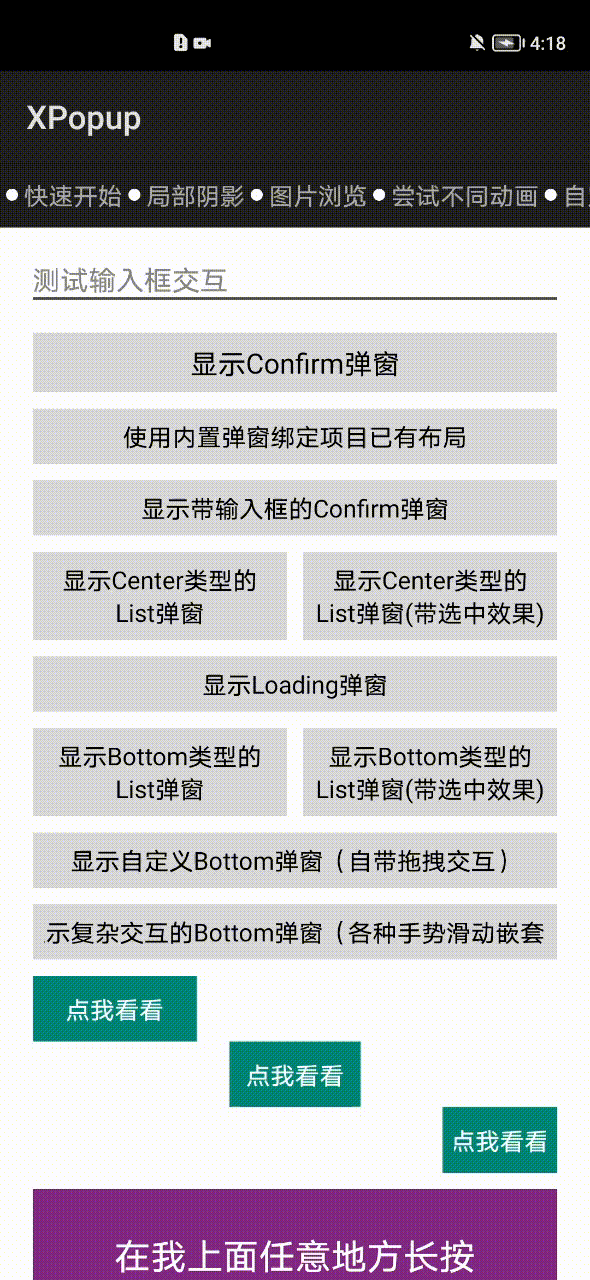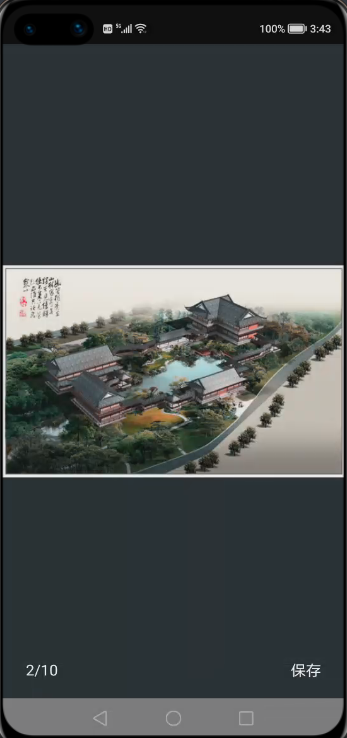目录:
1、介绍
2、效果一览
3、依赖
4、如何使用
5、下载链接
6、《鸿蒙开源三方组件》文章合集
1. 介绍
XPopup是一个弹窗库,可能是Harmony平台最好的弹窗库。它从设计的时候就本着实用的原则,兼顾了美观和优雅的交互。用户都喜欢自然舒适的UI和交互,希望XPopup能带给你一些帮助或者惊喜!
2. 效果一览
| 内置弹窗(支持复用已有布局) | 列表Center弹窗 |
|---|---|
 |  |
| Bottom列表弹窗 | 自定义Bottom弹窗 |
|---|---|
 |  |
| Attach弹窗(动画优雅,智能定位,长按支持) | 自定义Attach弹窗(任意方向支持,灵活易用) |
|---|---|
 |  |
| Drawer弹窗 | 全屏弹窗(可作为Ability替代品,搭配十几个动画使用更佳) |
|---|---|
 |  |
| Position自由定位弹窗(放在屏幕任意地方) | 自定义底部弹窗 |
|---|---|
 |  |
| 自定义弹窗和自定义动画 | 内置优雅美观的动画器,可搭配弹窗结合使用 |
|---|---|
 |  |
| ImageViewer大图浏览弹窗 | 联想搜索实现,轻而易举 |
|---|---|
 |  |
3. 依赖
`allprojects<span class="token punctuation">{</span>
repositories<span class="token punctuation">{</span>
<span class="token function">mavenCentral</span><span class="token punctuation">()</span>
<span class="token punctuation">}</span><span class="token punctuation">}</span>
implementation <span class="token string">'io.openharmony.tpc.thirdlib:XPopup:1.0.3'</span>`
4. 如何使用
4.1 内置弹窗的使用
4.1.1 显示确认和取消对话框
`<span class="token keyword">new</span> <span class="token class-name">XPopup<span class="token punctuation">.</span>Builder</span><span class="token punctuation">(</span><span class="token function">getContext</span><span class="token punctuation">(</span><span class="token punctuation">)</span><span class="token punctuation">)</span><span class="token punctuation">.</span><span class="token function">asConfirm</span><span class="token punctuation">(</span><span class="token string">"我是标题"</span><span class="token punctuation">,</span> <span class="token string">"我是内容"</span><span class="token punctuation">,</span>
<span class="token keyword">new</span> <span class="token class-name">OnConfirmListener</span><span class="token punctuation">(</span><span class="token punctuation">)</span> <span class="token punctuation">{</span>
<span class="token annotation punctuation">@Override</span>
<span class="token keyword">public</span> <span class="token keyword">void</span> <span class="token function">onConfirm</span><span class="token punctuation">(</span><span class="token punctuation">)</span> <span class="token punctuation">{</span>
<span class="token function">toast</span><span class="token punctuation">(</span><span class="token string">"click confirm"</span><span class="token punctuation">)</span><span class="token punctuation">;</span>
<span class="token punctuation">}</span>
<span class="token punctuation">}</span><span class="token punctuation">)</span>
<span class="token punctuation">.</span><span class="token function">show</span><span class="token punctuation">(</span><span class="token punctuation">)</span><span class="token punctuation">;</span>`
<br>
<br>
4.1.3 显示中间弹出的列表弹窗
new XPopup.Builder(getContext())
//.maxWidth(600)
.asCenterList("请选择一项", new String[]{"条目1", "条目2", "条目3", "条目4"},
new OnSelectListener() {
@Override
public void onSelect(int position, String text) {
toast("click " + text);
}
})
.show();4.1.4 显示中间弹出的加载框
new XPopup.Builder(getContext())
.asLoading("正在加载中")
.show();
4.1.5 显示从底部弹出的列表弹窗
new XPopup.Builder(getContext())
.asBottomList("请选择一项", new String[]{"条目1", "条目2", "条目3", "条目4", "条目5"},
new OnSelectListener() {
@Override
public void onSelect(int position, String text) {
toast("click " + text);
}
})
.show();
4.1.6 显示依附于某个Component或者某个点的弹窗
new XPopup.Builder(getContext())
.atView(component) // 依附于所点击的Component,内部会自动判断在上方或者下方显示
.asAttachList(new String[]{"分享", "编辑", "不带icon"},
new int[]{ResourceTable.Media_icon, ResourceTable.Media_icon},
new OnSelectListener() {
@Override
public void onSelect(int position, String text) {
toast("click " + text);
}
})
.show();
如果是想依附于某个Component的触摸点,则需要先watch该Component,然后当单击或长按触发的时候去显示:
Component component = findComponentById(ResourceTable.Id_btnShowAttachPoint);
// 必须在事件发生前,调用这个方法来监视View的触摸
final XPopup.Builder builder = new XPopup.Builder(getContext()).watchView(component);
component.setLongClickedListener(new LongClickedListener() {
@Override
public void onLongClicked(Component component) {
builder.asAttachList(new String[]{"置顶", "复制", "删除"}, null,
new OnSelectListener() {
@Override
public void onSelect(int position, String text) {
toast("click " + text);
}
})
.show();
}
});asAttachList方法内部是对AttachPopupView的封装,如果你的布局不是列表,可以继承AttachPopupView实现自己想要的布局。AttachPopupView会出现在目标的上方或者下方,如果你想要出现在目标的左边或者右边(像微信朋友圈那样点赞的弹窗),可以继承HorizontalAttachPopupView,然后编写你的布局即可。
最简单的示例如下:
public class CustomAttachPopup extends HorizontalAttachPopupView {
public CustomAttachPopup(Context context) {
super(context, null);
}
@Override
protected int getImplLayoutId() {
return ResourceTable.Layout_custom_attach_popup;
}
@Override
protected void onCreate() {
super.onCreate();
findComponentById(ResourceTable.Id_tv_zan).setClickedListener(new ClickedListener() {
@Override
public void onClick(Component component) {
ToastUtil.showToast(getContext(), "赞");
dismiss();
}
});
findComponentById(ResourceTable.Id_tv_comment).setClickedListener(new ClickedListener() {
@Override
public void onClick(Component component) {
ToastUtil.showToast(getContext(), "评论");
dismiss();
}
});
} // 设置状态栏的高度,用以修正自定义位置弹窗的高度
@Override
protected int setStatusBarHeight() {
return 130;
}}
4.1.7 显示大图浏览弹窗
// 当你点击图片的时候执行以下代码:
// 多图片场景(你有多张图片需要浏览)
new XPopup.Builder(getContext()).asImageViewer(image, position, list,
new OnSrcViewUpdateListener() {
@Override
public void onSrcViewUpdate(ImageViewerPopupView popupView, int position) {
// pager更新当前显示的图片
// 当启用isInfinite时,position会无限增大,需要映射为当前ViewPager中的页
int realPosi = position % list.size();
pager.setCurrentPage(realPosi, false);
}
}, new ImageLoader()).show();
// 单张图片场景
new XPopup.Builder(getContext())
.asImageViewer(image, url, new ImageLoader())
.show();// 图片加载器,XPopup不负责加载图片,需要你实现一个图片加载器传给我,这里以Glide和OkGo为例(可直接复制到项目中):
class ImageLoader implements XPopupImageLoader {
@Override
public void loadImage(int position, String url, Image imageView) {
// 一进入页面就加载图片的话,需要加点延迟
context.getUITaskDispatcher().delayDispatch(new Runnable() {
@Override
public void run() {
Glide.with(context)
.load(url)
.diskCacheStrategy(DiskCacheStrategy.ALL)
.into(image);
}
}, 50);
}
// 必须实现这个方法,用来下载图片。可参照下面的实现,内部保存图片会用到。如果你不需要保存图片这个功能,可以返回null。
@Override
public File getImageFile(Context context, String url) {
try {
return OkGo.<File>get(url).tag(this).converter(new FileConvert()).adapt().execute().body();
} catch (Exception e) {
LogUtil.error(TAG, e.getMessage());
}
return null;
}
}
如果你用的不是Glide,请参考去实现即可。
4.1.8 关闭弹窗
先拿到弹窗对象,以Loading弹窗为例,其他也是一样:
BasePopupView popupView = new XPopup.Builder(getContext())
.asLoading("正在加载中")
.show();
执行消失:
//有四个消失方法可供选择:
popupView.dismiss();
//立即消失
popupView.delayDismiss(300);
//延时消失,有时候消失过快体验可能不好,可以延时一下
popupView.smartDismiss();
//会等待弹窗的开始动画执行完毕再进行消失,可以防止接口调用过快导致的动画不完整。
popupView.dismissWith({});
//消失动画执行完之后执行某些逻辑我们在项目中经常会点击某个按钮然后关闭弹窗,接着去做一些事。比如:点击一个按钮,关闭弹窗,然后开启一个界面,要知道弹窗的关闭是有一个动画过程的,上面的写法会出现弹窗还没有完全关闭,就立即跳页面,界面有一种顿挫感;而且在设备资源不足的时候,还可能造成丢帧。所以很多时候不推荐直接使用dismiss()方法,除非你关闭完弹窗后面没有任何逻辑执行。
为了得到最佳体验,您可以等dismiss动画完全结束去执行一些东西,而不是立即就执行。可以这样做:
popupView.dismissWith(new Runnable() {
@Override
public void run() {
// 跳转到新页面
}});每个弹窗本身也有onShow()和onDismiss()的生命周期回调,可以根据需要使用。
还有这样一种场景:弹窗show()完之后,你的逻辑执行完毕,然后调用dismiss()。但是你的逻辑执行过快,可能导致弹窗的show动画还没有执行完就直接dismiss了,界面上的感觉并不好。这个时候推荐使用smartDismiss()方法,这个方法能保证弹窗的show动画执行完再关闭弹窗。
4.1.9 复用项目已有布局
如果你项目中已经有写好的弹窗布局,而想用XPopup提供的动画和交互能力,也是完全没有问题的。目前支持设置自定义布局的弹窗有:
- Confirm弹窗,就是确认和取消弹窗
- 带输入框的Confirm弹窗
- Loading弹窗
- 带列表的Attach弹窗,Center弹窗和Bottom弹窗
假设,你想使用XPopup的Confirm弹窗,但布局想用自己的,只需要这样设置一下,其他不用动即可:
new XPopup.Builder(getContext())
.asConfirm(null, "您可以复用项目已有布局,来使用XPopup强大的交互能力和逻辑封装,弹窗的布局完全由你自己控制。\n" +
"需要注意的是:你自己的布局必须提供一些控件Id,否则XPopup找不到控件。",
"关闭", "XPopup牛逼",
new OnConfirmListener() {
@Override
public void onConfirm() {
toast("click confirm");
}
}, null, false, ResourceTable.Layout_my_confim_popup)//绑定已有布局
.show();这样布局就是您自己的了,动画和交互XPopup会帮你完成。但是需要注意的是,你自己提供的布局必须包含一些id,否则XPopup无法找到控件;id必须有,控件你可以随意组合与摆放。具体如下:
- Confirm弹窗必须包含的Text以及id有:tv\_title,tv\_content,tv\_cancel,tv\_confirm
- 带输入框的Confirm弹窗在Confirm弹窗基础上需要增加一个id为et\_input的TextField
- Loading弹窗,如果你想显示一个Loading文字说明,则必须有一个id为tv\_title的Text;如果不需要文字说明,则没要求
- 带列表的弹窗会多一个bindItemLayout()方法用来绑定item布局
- 其他不在多说,看bindLayout方法说明,会说明要求哪些id
每种内置弹窗的bindLayout和bindItemLayout的要求都在方法说明上,无需记忆,用的时候查看下方法的说明即可。
4.2 自定义弹窗
当你自定义弹窗的时候,需要根据需求选择继承CenterPopupView,BottomPopupView,AttachPopupView/HorizontalAttachPopupView,DrawerPopupView,PartShadowPopupView,FullScreenPopupView,PositionPopupView其中之一。
每种弹窗的功能和使用场景如下:
- CenterPopupView:中间弹窗的弹窗,比如:确认取消对话框,Loading弹窗等,如果不满意默认的动画效果,可以设置不同的动画器
- BottomPopupView:从底部弹出的弹窗,比如:从底部弹出的分享弹窗,知乎的从底部弹出的评论弹窗,抖音从底部弹出的评论弹窗。这种弹窗带有智能的嵌套滚动和手势拖动
- AttachPopupView/HorizontalAttachPopupView:Attach弹窗是需要依附于某个点或者某个Component来显示的弹窗;其中AttachPopupView会出现在目标的上方或者下方。如果希望想要微信朋友圈点赞弹窗那样的效果,出现在目标的左边或者右边,则需要继承
HorizontalAttachPopupView来做 - DrawerPopupView:从界面的左边或者右边弹出的像DrawerLayout那样的弹窗,Drawer弹窗本身是横向滑动的,但对PageSlider和ScrollView等横向滑动控件做了兼容,在弹窗内部可以放心使用它们
- FullScreenPopupView:全屏弹窗,看起来和Ability 一样。该弹窗其实是继承Center弹窗进行的一种实现,可以设置任意的动画器
- ImageViewerPopupView:大图浏览弹窗
- PositionPopupView:自由定位弹窗,如果你想让弹窗显示在左上角,或者右上角,或者任意位置,并且不需要依附任何Component,此时你需要它
自定义弹窗只有2个步骤:
一:根据自己的需求编写一个类继承对应的弹窗
二:重写getImplLayoutId()返回弹窗的布局,在onCreate中像Ability那样编写你的逻辑即可
注意:自定义弹窗本质是一个自定义控件,但是只需重写一个参数的构造,其他的不要重写,所有的自定义弹窗都是这样。
4.2.1 自定义Center弹窗
class CustomPopup extends CenterPopupView {
//注意:自定义弹窗本质是一个自定义控件,但是只需重写一个参数的构造,其他的不要重写,所有的自定义弹窗都是这样
public CustomPopup(Context context) {
super(context, null);
}
// 返回自定义弹窗的布局
@Override
protected int getImplLayoutId() {
return ResourceTable.Layout_custom_popup;
}
// 执行初始化操作,比如:findComponentById,设置点击,或者任何你弹窗内的业务逻辑
@Override
protected void onCreate() {
super.onCreate();
findComponentById(ResourceTable.Id_tv_close).setClickedListener(new ClickedListener() {
@Override
public void onClick(Component component) {
dismiss(); // 关闭弹窗
}
});
}
// 设置最大宽度,看需要而定
@Override
protected int getMaxWidth() {
return super.getMaxWidth();
}
// 设置最大高度,看需要而定
@Override
protected int getMaxHeight() {
return super.getMaxHeight();
}
// 设置自定义动画器,看需要而定
@Override
protected PopupAnimator getPopupAnimator() {
return super.getPopupAnimator();
}
// 弹窗的宽度,用来动态设定当前弹窗的宽度,受getMaxWidth()限制
protected int getPopupWidth() {
return 0;
}
// 弹窗的高度,用来动态设定当前弹窗的高度,受getMaxHeight()限制
protected int getPopupHeight() {
return 0;
}}注意:Center弹窗的最大宽度默认是屏幕宽度的0.8,如果你自定义布局的宽度是写死的,有可能超出屏幕宽度的0.8,如果你不想被最大宽度限制,只需要重写方法:
@Overrideprotected int getMaxWidth() {
return 0;
//返回0表示不限制最大宽度
}使用自定义弹窗:
new XPopup.Builder(getContext())
.asCustom(new CustomPopup(getContext()))
.show();4.2.2 自定义Attach弹窗
public class CustomAttachPopup2 extends AttachPopupView {
public CustomAttachPopup2(Context context) {
super(context, null);
}
@Override
protected int getImplLayoutId() {
return ResourceTable.Layout_custom_attach_popup2;
}
// 设置状态栏的高度,用以修正自定义位置弹窗的高度
@Override
protected int setStatusBarHeight() {
return 130;
}}4.2.3 自定义DrawerLayout类型弹窗
public class CustomDrawerPopupView extends DrawerPopupView {
public CustomDrawerPopupView(Context context) {
super(context, null);
}
@Override
protected int getImplLayoutId() {
return ResourceTable.Layout_custom_list_drawer;
}
@Override
protected void onCreate() {
super.onCreate();
findComponentById(ResourceTable.Id_btn).setClickedListener(new ClickedListener() {
@Override
public void onClick(Component component) {
toast("nothing!!!");
}
});
}}使用自定义的DrawerLayout弹窗:
new XPopup.Builder(getContext())
.popupPosition(PopupPosition.Right)//右边
.asCustom(new CustomDrawerPopupView(getContext()))
.show();4.2.4 自定义Bottom类型的弹窗
自定义Bottom类型的弹窗会比较常见,默认Bottom弹窗带有手势交互和嵌套滚动;如果您不想要手势交互可以调用enableDrag(false)方法关闭。
请注意:弹窗的宽高是自适应的,大部分情况下都应该将弹窗布局的高设置为match_content;除非你希望得到一个高度撑满的弹窗。
Demo中有一个模仿知乎评论的实现,代码如下:
public class ZhihuCommentPopup extends BottomPopupView {
ListContainer listContainer;
public ZhihuCommentPopup(Context context) {
super(context, null);
}
@Override
protected int getImplLayoutId() {
return ResourceTable.Layout_custom_bottom_popup;
}
@Override
protected void onCreate() {
super.onCreate();
listContainer = (ListContainer) findComponentById(ResourceTable.Id_listContainer);
ArrayList<String> strings = new ArrayList<>();
for (int i = 0; i < 30; i++) {
strings.add("");
}
EasyProvider commonAdapter = new EasyProvider<String>(getContext(), strings, ResourceTable.Layout_adapter_zhihu_comment) {
@Override
protected void bind(ViewHolder holder, String itemData, final int position) {}
};
listContainer.setItemClickedListener(new ListContainer.ItemClickedListener() {
@Override
public void onItemClicked(ListContainer listContainer, Component component, int position, long id) {
dismiss();
}
});
listContainer.setItemProvider(commonAdapter);
}
// 最大高度为Window的0.7
@Override
protected int getMaxHeight() {
return (int) (XPopupUtils.getScreenHeight(getContext()) * .7f);
}}4.2.5 自定义全屏弹窗
public class CustomFullScreenPopup extends FullScreenPopupView {
public CustomFullScreenPopup(Context context) {
super(context, null);
}
@Override
protected int getImplLayoutId() {
return ResourceTable.Layout_custom_fullscreen_popup;
}
@Override
protected void onCreate() {
super.onCreate();
// 初始化
}}4.2.6 自定义ImageViewer弹窗
目前大图浏览弹窗支持在上面添加任意自定义布局和背景颜色,做法是写一个类继承ImageViewerPopupView弹窗,然后重写布局即可。
代码如下:
public class CustomImagePopup extends ImageViewerPopupView {
public CustomImagePopup(Context context) {
super(context, null);
}
@Override
protected int getImplLayoutId() {
return ResourceTable.Layout_custom_image_viewer_popup;
}}由于是自定义的大图浏览弹窗,就要用自定义弹窗的方式来开启了:
// 自定义的弹窗需要用asCustom来显示,之前的asImageViewer这些方法当然不能用了。
CustomImagePopup viewerPopup = new CustomImagePopup(getContext());
// 自定义的ImageViewer弹窗需要自己手动设置相应的属性,必须设置的有srcView,url和imageLoader。
viewerPopup.setSingleSrcView(image2, url2);
viewerPopup.setXPopupImageLoader(new ImageLoader());
new XPopup.Builder(getContext())
.asCustom(viewerPopup)
.show();4.2.7 自定义Position弹窗
public class QQMsgPopup extends PositionPopupView {
public QQMsgPopup(Context context) {
super(context, null);
}
@Override
protected int getImplLayoutId() {
return ResourceTable.Layout_popup_qq_msg;
}}自由定位弹窗,默认是显示在屏幕的左上角,你可以通过offsetX()和offsetY()来控制显示位置,如果你希望水平居中,可以用isCenterHorizontal(true)选项来做到。
new XPopup.Builder(getContext())
.popupAnimation(PopupAnimation.ScaleAlphaFromCenter)
.isCenterHorizontal(true)
.offsetY(200)
.asCustom(new QQMsgPopup(getContext()))
.show();4.3 自定义动画
自定义动画已经被设计得非常简单,动画和弹窗是无关的;这意味着你可以将动画设置给内置弹窗或者自定义弹窗。继承PopupAnimator,实现3个方法:
- 如何初始化动画
- 动画如何开始
- 动画如何结束
比如:自定义一个旋转的动画:
class RotateAnimator extends PopupAnimator {
@Override
public void initAnimator() {
targetView.setScaleX(0.0f);
targetView.setScaleY(0.0f);
targetView.setAlpha(0.0f);
targetView.setRotation(360.0f);
}
@Override
public void animateShow() {
targetView.createAnimatorProperty().rotate(0.0f).scaleX(1.0f).scaleY(1.0f).alpha(1.0f).setDuration(getDuration()).start();
}
@Override
public void animateDismiss() {
targetView.createAnimatorProperty().rotate(720.0f).scaleX(0.0f).scaleY(0.0f).alpha(0.0f).setDuration(getDuration()).start();
}}
使用自定义动画:
new XPopup.Builder(getContext())
.customAnimator(new RotateAnimator())
.asConfirm("演示自定义动画", "当前的动画是一个自定义的旋转动画,无论是自定义弹窗还是自定义动画,已经被设计得非常简单;这个动画代码只有6行即可完成!", null)
.show();
不想要动画:
new XPopup.Builder(getContext())
.customAnimator(new EmptyAnimator(null))
.asConfirm("演示自定义动画", "当前的动画是一个自定义的旋转动画,无论是自定义弹窗还是自定义动画,已经被设计得非常简单;这个动画代码只有6行即可完成!", null)
.show();
4.4 常用设置
4.4.1 全局设置
- 设置主色调 默认情况下,XPopup的主色为灰色,主色作用于Button文字,TextField边框和光标,Check文字的颜色上。 主色调只需要设置一次即可,可以放在启动页中。
`<span class="token class-name">XPopup</span><span class="token punctuation">.</span><span class="token function">setPrimaryColor</span><span class="token punctuation">(</span><span class="token function">getColor</span><span class="token punctuation">(</span><span class="token class-name">ResourceTable<span class="token punctuation">.</span>Color\_colorPrimary</span><span class="token punctuation">)</span><span class="token punctuation">)</span><span class="token punctuation">;</span>`
<li>设置全局的动画时长 默认情况下,弹窗的动画时长为360毫秒。你可以通过下面的方法进行修改:
`<span class="token class-name">XPopup</span><span class="token punctuation">.</span><span class="token function">setAnimationDuration</span><span class="token punctuation">(</span><span class="token number">200</span><span class="token punctuation">);</span> <span class="token comment">// 传入的时长最小为0,动画的时长会影响除Drawer弹窗外的所有弹窗</span>`
</li>
4.4.2 常用设置
所有的设置如下,根据需要使用:
new XPopup.Builder(getContext())
.isDestroyOnDismiss(true) //是否在消失的时候销毁资源,默认false。如果你的弹窗对象只使用一次,非常推荐设置这个,可以杜绝内存泄漏。如果会使用多次,千万不要设置
.dismissOnBackPressed(true) //按返回键是否关闭弹窗,默认为true
.dismissOnTouchOutside(true) //点击外部是否关闭弹窗,默认为true
.autoOpenSoftInput(true) //是否弹窗显示的同时打开输入法,只在包含输入框的弹窗内才有效,默认为false
.popupAnimation(PopupAnimation.ScaleAlphaFromCenter) //设置内置的动画
.customAnimator(null) //设置自定义的动画器
.popupPosition(PopupPosition.Right) //手动指定弹窗出现在目标的什么位置,对Attach和Drawer类型弹窗生效
.positionByWindowCenter(false) //默认是false,是否以屏幕中心进行定位,默认是false,为false时根据Material范式进行定位,主要影响Attach系列弹窗
.offsetX(-10) //弹窗在x方向的偏移量 .offsetY(-10) //弹窗在y方向的偏移量
.maxWidth(10) //设置弹窗的最大宽度,如果重写弹窗的getMaxWidth(),以重写的为准
.maxHeight(10) //设置弹窗的最大高度,如果重写弹窗的getMaxHeight(),以重写的为准
.isCenterHorizontal(true) //是否和目标水平居中,比如:默认情况下Attach弹窗依靠着目标的左边或者右边,如果isCenterHorizontal为true,则与目标水平居中对齐
.isRequestFocus(false) //默认为true,默认情况下弹窗会抢占焦点,目的是为了响应返回按键按下事件;如果为false,则不抢焦点
.enableDrag(true) //是否启用拖拽,默认为true,目前对Bottom和Drawer弹窗有用
.isDarkTheme(true) //是否启用暗色主题 .borderRadius(10) //为弹窗设置圆角,默认是15,对内置弹窗生效
.autoDismiss(false) //操作完毕后是否自动关闭弹窗,默认为true;比如点击ConfirmPopup的确认按钮,默认自动关闭;如果为false,则不会关闭
.setPopupCallback(new SimpleCallback() { //设置显示和隐藏的回调
@Override public void onCreated(BasePopupView basePopupView) {
// 弹窗内部onCreate执行完调用
}
@Override
public void beforeShow(BasePopupView basePopupView) {
// 每次show之前都会执行
}
@Override
public void onShow(BasePopupView basePopupView) {
// 完全显示的时候执行
}
@Override
public void onDismiss(BasePopupView basePopupView) {
// 完全隐藏的时候执行
}
// 如果你自己想拦截返回按键事件,则重写这个方法,返回true即可
@Override
public boolean onBackPressed(BasePopupView basePopupView) {
new ToastDialog(getContext()).setText("我拦截的返回按键,按返回键XPopup不会关闭了").show();
return true; //默认返回false
}
//监听弹窗拖拽,适用于能拖拽的弹窗
@Override
public void onDrag(BasePopupView popupView, int value, float percent,boolean upOrLeft) {
}
})
.asXXX() //所有的设置项都要写在asXXX()方法调用之前
5. 下载链接
5.1 IDE下载链接
https://developer.harmonyos.com/cn/develop/deveco-studio#download
5.2 源码链接
https://gitee.com/openharmony-tpc/XPopup
作者:朱伟ISRC
想了解更多内容,请访问51CTO和华为合作共建的鸿蒙社区:https://harmonyos.51cto.com



